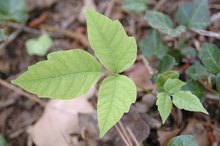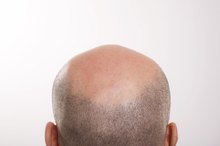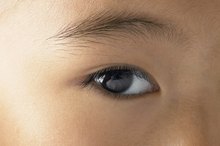Diseases Causing Skin Rash
There are many diseases that cause skin rash. According to MedlinePlus, rashes affect the color or texture in a person's skin 1. The cause of a rash can often be determined based on the observable characteristics of the rash and other accompanying symptoms. It's important to identify and avoid any products that might irritate a the skin and cause a rash. Sometimes, diseases are the cause of skin rashes.
If you are experiencing serious medical symptoms, seek emergency treatment immediately.
Atopic Dermatitis
Atopic dermatitis is a disease that causes skin rash 2. According to the National Institute of Arthritis and Musculoskeletal and Skin Diseases, atopic dermatitis, also known as eczema, is a chronic or long-lasting disease that affects a person's skin 2. It is not contagious and cannot be passed between people.
The NIAMS states that atopic dermatitis is characterized by itchy skin that leads to redness, swelling and cracking of the skin, along with clear fluid, crusting and scaling. People with atopic dermatitis often experience flare-ups followed by periods of remission, where no skin rash is present. The NIAMS also notes that atopic dermatitis may disappear entirely as a child grows older, although most people who develop atopic dermatitis as a child retain dry skin that's easily irritated. Some people continue to experience the characteristic symptoms of atopic dermatitis well into adulthood.
- Atopic dermatitis is a disease that causes skin rash 2.
- The NIAMS states that atopic dermatitis is characterized by itchy skin that leads to redness, swelling and cracking of the skin, along with clear fluid, crusting and scaling.
Pityriasis Rosea
What Are the Causes of Intense Painful Itching?
Learn More
According to the AAD, the pityriasis rosea-related rash typically does not cause permanent marks or scarring, although darker-skinned individuals may experience long-lasting flat brown spots on the skin that eventually fade 3. Although pityriasis rosea can occur at any point throughout the year, it appears to be most common in the spring and fall 3. MayoClinic.com states that common signs and symptoms of pityriasis rosea include a herald patch, which is a large, slightly elevated and scaly patch on the back, chest or abdomen, and symptoms of an upper respiratory infection such as:
- headache
- stuffy nose
- sore throat
- mild fever 3
Scarlet Fever
According to the U.S. Centers for Disease Control and Prevention, scarlet fever, also known as scarlatina, is a rash-causing disease resulting from infection with group A Streptococcus bacteria. Scarlet fever is characterized by a rash and a strawberry-like appearance of the tongue; it is typically seen in children younger than 18 years of age.
The rash often first appears as tiny red bumps on a person's chest and stomach, but it can quickly spread throughout the body. According to the CDC, the rash usually looks like a sunburn and possesses a texture similar to a piece of sandpaper. It may be redder in certain areas of the body, including the elbow creases, the arm pits and the groin area. The rash lasts for approximately two to seven days, and after it disappears, the skin on the tips of a person's fingers and toes begin to peel.
- According to the U.S. Centers for Disease Control and Prevention, scarlet fever, also known as scarlatina, is a rash-causing disease resulting from infection with group A Streptococcus bacteria.
- The rash lasts for approximately two to seven days, and after it disappears, the skin on the tips of a person's fingers and toes begin to peel.
Related Articles
References
- MedlinePlus: Rashes
- National Institute of Arthritis and Musculoskeletal and Skin Diseases: Atopic Dermatitis
- MayoClinic.com: Pityriasis Rosea
- Owen JL, Vakharia PP, Silverberg JI. The role and diagnosis of allergic contact dermatitis in patients with atopic dermatitis. Am J Clin Dermatol. 2018;19(3):293-302. doi:10.1007/s40257-017-0340-7
- Fonacier L, Bernstein DI, Pacheco K, et al. Contact dermatitis: a practice parameter-update 2015. J Allergy Clin Immunol Pract. 2015;3(3 Suppl):S1-39. doi:10.1016/j.jaip.2015.02.009
- Thomsen SF. Atopic dermatitis: Natural history, diagnosis, and treatment. ISRN Allergy. 2014; 2014:354250. doi:10.1155/2014/354250
- National Institute for Occupational Safety and Health. Poisonous plants. Updated June 1, 2018.
- Chopra R, Vakharia PP, Sacotte R, Silverberg JI. Efficacy of bleach baths in reducing severity of atopic dermatitis: A systematic review and meta-analysis. Ann Allergy Asthma Immunol. 2017;119(5):435-440. doi:10.1016/j.anai.2017.08.289
- Maarouf M, Shi VY. Bleach for atopic dermatitis. Dermatitis. 2018;29(3):120-126. doi:10.1097/DER.0000000000000358
Writer Bio
Martin Hughes is a chiropractic physician, health writer and the co-owner of a website devoted to natural footgear. He writes about health, fitness, diet and lifestyle. Hughes earned his Bachelor of Science in kinesiology at the University of Waterloo and his doctoral degree from Western States Chiropractic College in Portland, Ore.








